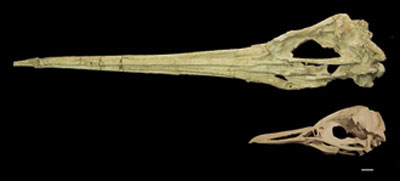Past global warming produced giant penguins
Past global warming produced monster penguins
mongabay.com
June 25, 2007
Scientists have discovered fossil remains of a giant species of penguin that lived some 40 million years ago in what is now Peru. Coupled with the finding of a smaller species from the same time period, the remains reveal that early penguins responded differently to natural climate change than scientists would have expected. The results are published in the PNAS Online Early Edition the week of June 25-29, 2007.

Reconstructions of the first Paleogene penguins from equatorial regions, illustrating morphological diversity and size range in present the new early penguin faunas. The late Eocene giant penguin Icadyptes salasi (right) and the middle Eocene Perudyptes devriesi (left) are shown to scale with the only extant penguin inhabiting Peru, Spheniscus humbolti (center). Icadyptes salasi is the first giant penguin known from a complete skull and had an estimated standing height of 1.5m. Perudyptes devriesi is known from one of the most complete skeletons of a more basal part of the penguin lineage. Together these new finds are revolutionizing our understanding of biogeography and timing of diversification in the penguin lineage. Art by Kristin Lamm. |
Excavating skulls and partial skeletons in the coastal desert of Peru, North Carolina State University researcher Julia Clarke and colleagues, discovered two extinct penguin species dating from the middle and late Eocene period, 42 and 36 million years ago, one of the warmest periods of global climate over the past 65 million years. The larger penguin, Icadyptes salasi, stood at over five feet tall with a seven-inch beak, while the smaller species, Perudyptes devriesi, was comparable in size to the living king penguin.
The existence of the larger penguin species during a “greenhouse” period came as a surprise to researchers who expected warmer temperatures to produce smaller penguins.
“Paleontologists generally assume that species moving from cold to warm climates become smaller, as the animals do not need to conserve heat,” explained a release from PNAS. “It is therefore surprising to find giant penguin fossils close to the equator, especially in the waning days of a greenhouse Earth. Prior to these findings, paleontologists assumed that penguins reached low latitudes only four to eight million years ago, during a period of much cooler climate.”

The first complete skull of a giant penguin. The skull is from the new species Icadyptes salasi (1.5m estimated standing height) from the late Eocene of Peru. Fine vascular texturing and other features of hyperelongate beak are unlike any extant or extinct penguin known. A skull of Spheniscus humbolti, the only species inhabiting Peru today, is shown for scale. Icadyptes salasi and a second new species described in this issue are revolutionizing our understanding of biogeography and diversity in the early penguin lineage. (Scale bar = 1cm). Photos courtesy of Daniel Ksepka. |
“With the discovery of the new Peruvian species, penguins show a much more complex relationship with climate factors early in their evolution,” wrote the authors.
CITATION: Julia A. Clarke, Daniel T. Ksepka, Marcelo Stucchi, Mario Urbina, Norberto Giannini, Sara Bertelli, Yanina Narváez, and Clint A. Boyd (2007). “Paleogene equatorial penguins challenge the proposed relationship between penguin biogeography, body size evolution, and Cenozoic climate change.” Proceedings of the National Academy of Sciences (PNAS) June 29, 2007.














